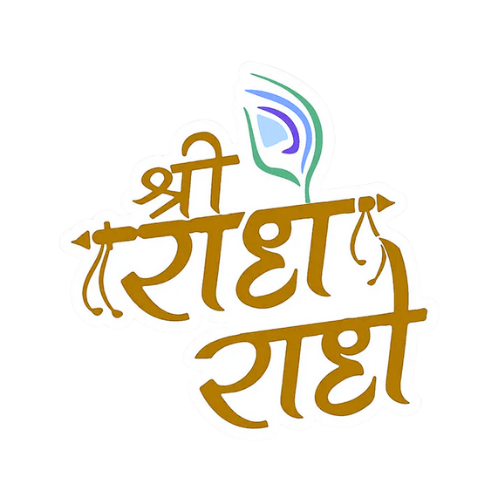
Close

Spanning over 252 kilometers (1 kos = ~3 km), this divine pilgrimage covers the entire Braj region — from Mathura to Barsana, Govardhan to Nandgaon, Gokul to Kamyavan. It traces the footsteps of Krishna's pastimes, saints’ realizations, and stories still whispered by trees
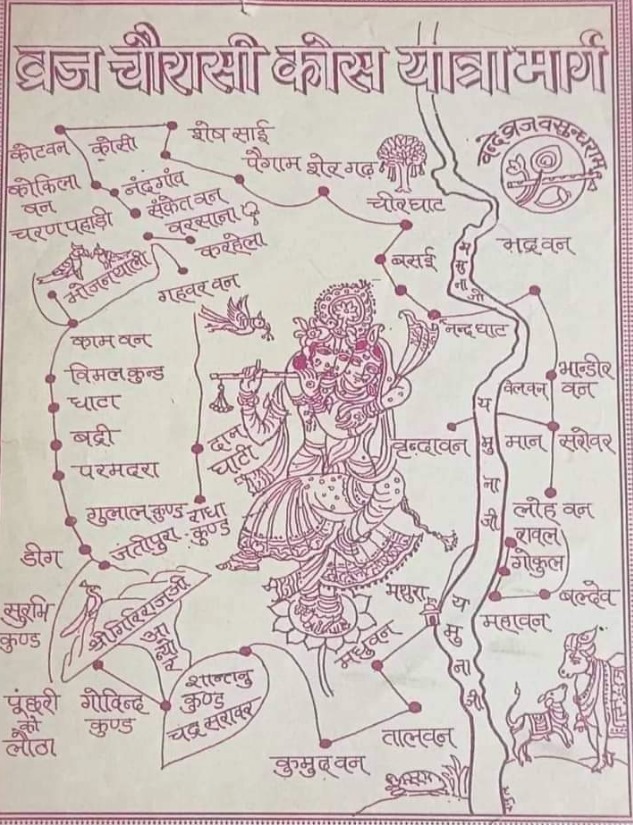
The 84 Kos Braj Yatra spans approximately 252 kilometers, circling the entire Braj Mandal — the divine playground of Shri Radha and Krishna. Traditionally performed barefoot, this pilgrimage covers 137+ sacred sites, each marking a leela of the Divine Couple. The term “84” signifies liberation from the 8.4 million life forms, granting moksha to those who walk it with devotion. The yatra is usually undertaken during the auspicious months of Chaitra and Kartik, when the air hums with kirtans and the fragrance of wild kadamba flowers fills the breeze. Pilgrims move through forests, riversides, and ancient villages, chanting the Holy Names and stopping for darshan at each tirtha.

Mathura is not just a city—it is the epicenter of eternity, where the Supreme Lord descended into the mortal plane. Known as Krishna Janmabhoomi, this sacred site is the very prison chamber of Kansa, where Devaki gave birth to the Divine Child at midnight on the eighth day of the waning moon of Bhadrapada (Janmashtami).
Here, the walls still echo with the cries of newborn Krishna, and the air itself vibrates with Hari Naam. Every pilgrim who steps into Mathura feels the cosmic alignment of dharma—as if the birth of Krishna is happening once again, right now, in their own heart.
Mathura is one of the seven Moksha-puris (cities granting liberation), alongside Ayodhya and Kashi.
Scriptures say: “Among all cities, Mathura is supreme, for there Govinda eternally resides.”
The Janmabhoomi temple complex is a palimpsest of history—destroyed and rebuilt across dynasties, yet never losing its aura of divinity.
Pilgrims chant “Nand ke ghar anand bhayo, Jai Kanhaiya Lal ki” as they circumambulate, reliving the joy of Krishna’s arrival.
Krishna Janmasthan Temple Complex – The exact site of Krishna’s birth, holding the sanctified prison cell (garbha-griha) where Devaki and Vasudeva welcomed the Lord.
Dwarkadhish Temple – An exquisite temple built in 1814, dedicated to Krishna as the King of Dwarka, with vibrant festivals of swing (hindola) and Holi.
Vishram Ghat – The most sacred bathing ghat on Yamuna, where Krishna rested after slaying Kansa. Evening Yamuna aarti here is a divine spectacle of lamps and chanting.
Potara Kund – The sacred pond where child Krishna’s clothes were washed.
Rangbhoomi – The wrestling arena where Krishna killed Kansa, restoring dharma to Mathura.
Walking Mathura’s streets is like stepping into timeless leela. The fragrance of incense, the call of Radhe Radhe, the bells of Dwarkadhish, and the serene flow of Yamuna all weave a spell. Pilgrims often say that the moment you close your eyes here, you can see baby Krishna crawling, smiling, and stealing butter.
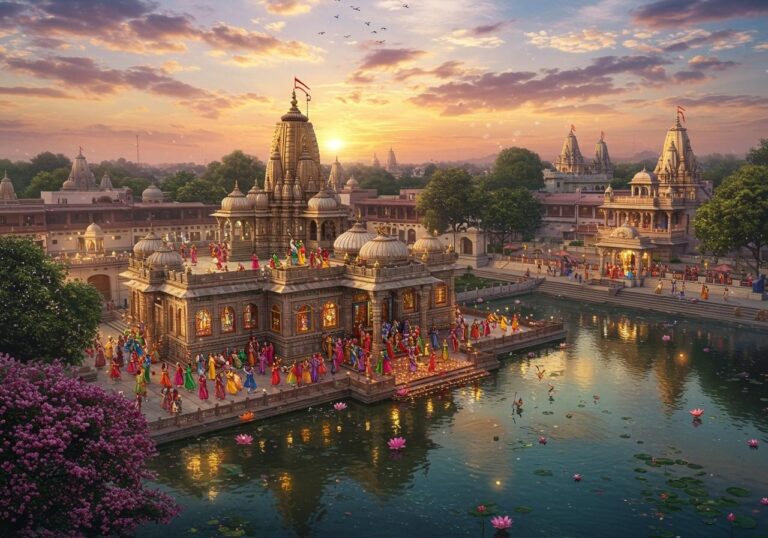
Vrindavan is not just a town—it is Goloka descended to earth. The scriptures say that Krishna never leaves Vrindavan. Even after He moved to Dwarka, His eternal form remained here, dancing with Radha and the gopis in the Raas Leela that never ends.
When you walk in Vrindavan, you don’t merely see temples—you feel the footprints of Krishna and Radha under your own feet. The dust (Braj Raj) here is worshipped by saints as more precious than jewels. It is said: “One speck of Vrindavan’s dust can grant what lifetimes of austerity cannot.”
Known as the playground of Krishna, Vrindavan is where His childhood and youthful pastimes blossomed.
Vrindavan is home to the Sapt Devalaya (seven most ancient temples) established by Goswamis in the 16th century under Chaitanya Mahaprabhu’s inspiration.
Saints like Meerabai, Surdas, and Chaitanya Mahaprabhu wandered here, intoxicated in Krishna-prema.
Every lane echoes the maha-mantra: “Hare Krishna Hare Krishna Krishna Krishna Hare Hare, Hare Rama Hare Rama Rama Rama Hare Hare.”
Banke Bihari Temple – The crown jewel of Vrindavan, where Shri Krishna stands in a three-fold bending posture (tribhanga). His eyes are so enchanting that the curtains open and close repeatedly to protect devotees from being overwhelmed.
Radha Raman Temple – Manifested from a saligram shila by Gopal Bhatta Goswami, this self-manifested deity is worshipped with unmatched devotion.
Radha Vallabh Temple – Symbolizing the inseparable love of Radha and Krishna, here Radha is worshipped in the form of a crown placed beside Krishna.
Prem Mandir – A modern marvel of white marble, glowing with scenes of Krishna’s leelas carved across its walls. At night, it looks like a palace of divine light.
ISKCON (Krishna Balaram Mandir) – A hub of global devotion, where Hare Krishna kirtan resounds day and night.
Nidhivan – The most mysterious leela-sthali. It is said that every night Radha-Krishna perform Raas here, and no one is allowed to stay after evening aarti. Trees here are twisted, as if frozen mid-dance.
Seva Kunj – A garden where Krishna used to comb Radha’s hair after Raas Leela. Even today, devotees feel the fragrance of sandalwood and flowers here.
Keshi Ghat – On the banks of Yamuna, where Krishna killed the horse-demon Keshi. Evening aarti at Keshi Ghat is a breathtaking sight of lamps floating on the sacred river.
Walking Vrindavan’s streets is like stepping into a living bhajan. Monkeys leap across temple domes, parrots sing Radhe Radhe, saints chant under kadamba trees, and the Yamuna flows gently with golden reflections. Devotees describe Vrindavan as not a place, but a feeling—a state of heart where one sees the world through Radha’s love for Krishna.

Barsana is no ordinary village—it is the crown of Braj, the hill of love where Shri Radha Rani manifested Her divine leela. Known in scriptures as Vrishabhanu-pura, Barsana rests upon four hills, said to represent the four heads of Brahma. Here, Radha grew up in the palace of Her father Vrishabhanu Maharaj, and every lane carries the fragrance of Her childhood laughter.
Saints sing:
“Vrishabhanu-dulari Radha, Vrindavan ki isha,
Jahan Radha wahan Shyam, dono ek prana visha.”
Barsana is the epicenter of Radha’s divine energy (hladini shakti).
Pilgrims say, “Vrindavan bina Radha adhura, Barsana bina Vrindavan adhura.”
The Lathmar Holi of Barsana is world-famous, symbolizing Radha’s playful dominance over Krishna and the gopas.
Each step here is a prayer to Radha, for only through Her compassion can one reach Krishna.
Shri Radha Rani Temple (Ladli Ji Mandir) – Situated atop Brahma Hill, this 5000-year-old temple is the spiritual heart of Barsana. Climbing the 200 steps to reach Radha’s darshan is itself a journey of devotion.
Maan Mandir – The cave-temple where Radha would come in maan (loving anger), and Krishna would beg for forgiveness. The cave still resonates with divine emotions.
Mor Kutir – The leela-sthali where Krishna danced like a peacock to please Radha. Even today, peacocks dance here in monsoon as if continuing the divine play.
Sankari Khor – The narrow pass between two hills where Krishna playfully stopped Radha and Her sakhis, demanding butter and curd as “tax”. Devotees reenact this leela with bhajans and laughter.
Prem Sarovar – A sacred lake near Barsana, where Radha and Krishna’s love reached its highest expression. It is said that when Krishna saw Radha in separation, both their tears filled the lake.
Radhashtami – Celebrated with unmatched grandeur, this is the divine birthday of Radha Rani. Thousands of devotees chant Radhe Radhe as the whole village turns into a garland of flowers.
Lathmar Holi – Here, women of Barsana playfully beat men from Nandgaon with sticks, while the men protect themselves with shields—symbolizing Radha’s playful power over Krishna’s village.
Jhulan Yatra – Swing festival where Radha and Krishna are seated on beautifully decorated swings.
In Barsana, the air itself feels lighter. Devotees climb the steps to Radha Rani temple chanting “Radhe Radhe”. At the top, when Radha’s darshan finally meets the eye, pilgrims often weep in joy, feeling Her motherly embrace.
Evenings in Barsana glow with the golden sun, peacocks call from the hills, and the sound of temple bells blends with villagers singing Radha’s name. Barsana is not just visited—it is felt in the core of one’s heart.
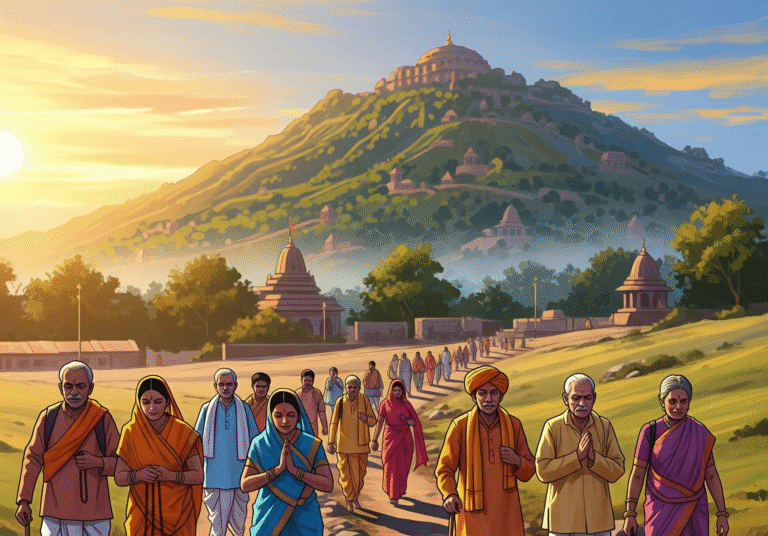
Govardhan, also lovingly called Giriraj Maharaj, is the eternal embodiment of Krishna’s protection and compassion. Rising gently from the Braj landscape, this hill is not just a mound of stones—it is the Supreme Lord in the form of a mountain, fulfilling the desires of His devotees.
The Govardhan Leela is one of the most celebrated episodes of Krishna’s childhood—when Indra, angered by the Vrajvasis for neglecting his worship, sent torrential rains to destroy them. Krishna, smiling with divine playfulness, lifted Govardhan Hill with His little finger and sheltered the entire community beneath it for seven days and nights. From that day, Govardhan became the eternal refuge of bhaktas.
Govardhan is revered as the topmost place in Braj, worshipped even above Vrindavan.
Shri Chaitanya Mahaprabhu carried Govardhan shilas (stones) close to His heart, worshipping them as Krishna Himself.
Scriptures declare: “Haridasa-varya Govardhan”—Govardhan is the best of Krishna’s servants.
To circumambulate Govardhan (Govardhan Parikrama) is considered equal to performing all holy pilgrimages.
Govardhan Parikrama (21 km) – Devotees walk barefoot around the hill chanting “Radhe Radhe”, collecting Braj Raj, and offering dandavats (prostrations). The full parikrama can take 6–7 hours and is performed especially during Kartik Purnima.
Radha Kund & Shyam Kund – The two most sacred ponds near Govardhan. Radha Kund was created by Radha Herself, and Shyam Kund by Krishna. Bathing here is said to grant the highest prema-bhakti.
Kusum Sarovar – A grand reservoir where gopis would pluck flowers for Krishna. Today, it glows with sandstone ghats and the tombs of Vallabhacharya saints. Sunset here feels like Krishna’s flute is calling.
Puchari Ka Lot (Tail of Govardhan) – The end point of the hill, associated with the humble monkey devotee who refused to leave Govardhan.
Annakut Utsav – Celebrated the day after Diwali, when mountains of food are offered to Govardhan in remembrance of Krishna’s leela. Every home in Braj prepares offerings of rice, dal, sweets, and vegetables for Giriraj.
Mansi Ganga – A lake near Govardhan town, believed to have manifested from Krishna’s mind (mana). Pilgrims start their parikrama here.
Performing Govardhan Parikrama is an experience beyond words. Devotees, barefoot and chanting, walk the 21 km route, their lips singing Radhe Radhe, their hearts melting in gratitude. Monkeys leap across the trees, cows graze peacefully, and the hill itself seems alive—listening, blessing, sheltering.
At night, lamps float upon Radha Kund, and the stars above seem like gopis watching the eternal Raas. Pilgrims say that during Parikrama, the hill breathes with you, carries your burdens, and fills your heart with Krishna’s love.
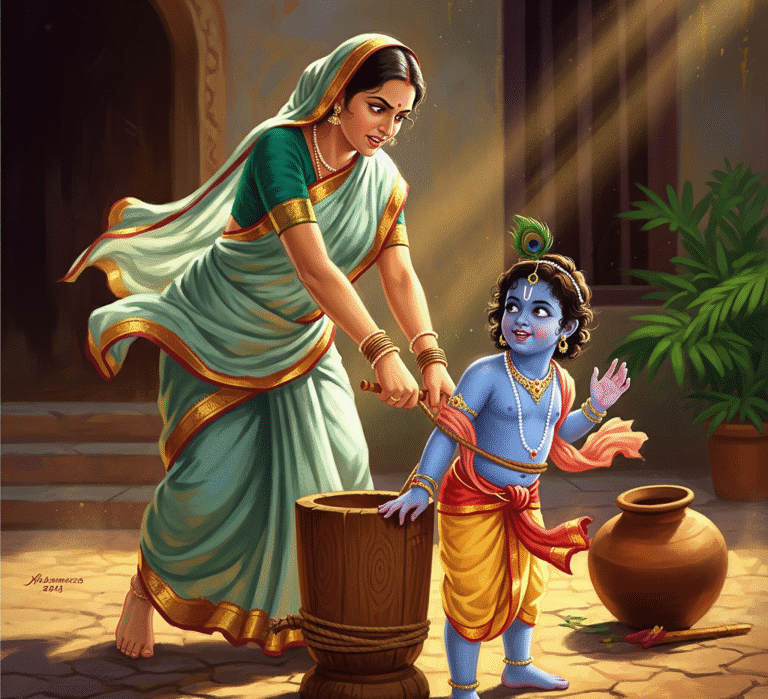
Gokul, resting on the banks of the Yamuna, is the cradle of Krishna’s earliest leelas. After Vasudeva carried the newborn Krishna across the flooded river to save Him from Kansa, the Lord grew up here in the loving home of Nanda Maharaj and Yashoda Maiya.
In these narrow lanes, the Lord who upholds the universe crawled on His hands and knees, stealing butter, breaking pots, and enchanting everyone with His innocent smile. Gokul is the place where the Supreme revealed Himself as a child—helpless, mischievous, yet supremely divine.
Gokul represents the balya-bhav (childhood mood) of Krishna. Here, He revealed that God can be bound by love, as Yashoda tied Him with a rope during the Damodar Leela.
It is in Gokul that Krishna killed demons like Putana, Trinavarta, and Shaktasura, while still a child.
Every lane of Gokul is a reminder that divinity shines through simplicity—through laughter, play, and innocent love.
Chaurasi Khamba (84 Pillars Temple) – Believed to be the palace of Nanda Maharaj, supported by 84 pillars. Each pillar resonates with Krishna’s childhood leelas.
Raman Reti – A sandy stretch where Krishna and Balaram would roll and play with their friends. Even today, devotees roll in the sand here, believing it carries Krishna’s touch.
Brahmand Ghat – The spot where Yashoda saw the entire universe inside Krishna’s mouth, when He ate mud. A leela that revealed the cosmic nature of the child.
Nand Bhavan – The home of Nanda Maharaj, where Krishna grew up with motherly care from Yashoda Maiya.
Ukhal Bandhan (Damodar Leela Sthali) – The courtyard where Yashoda tied Krishna to a mortar after His butter-stealing mischief. This leela teaches that the Lord can only be bound by pure love, not by ropes.
Gokulashtami (Janmashtami in Gokul style) – Celebrated with unique simplicity, where Krishna’s childhood pranks are reenacted.
Nandotsav – The day after Janmashtami, when sweets, butter, and curd are distributed in honor of Krishna’s arrival to Nanda’s home.
Annakut Utsav – Special offerings made to Krishna in gratitude for His protection.
Walking into Gokul feels like stepping back into Krishna’s childhood courtyard. Cows wander lazily, children play in the dust, and temples echo with soft bhajans of “Nand Ke Anandarupa, Jai Kanhaiya Lal Ki”.
At Brahmand Ghat, pilgrims gaze into the Yamuna waters and imagine Yashoda’s trembling hands when she saw galaxies within Krishna’s mouth. At Ukhal Bandhan, they tie small ropes, praying that their love too may bind Krishna in their hearts.
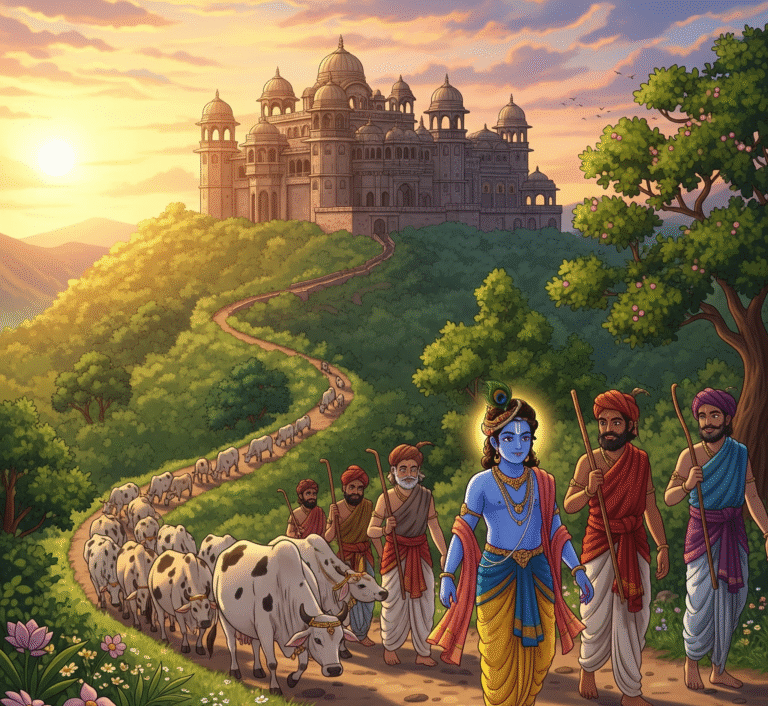
Perched upon a hill, Nandgaon shines as the abode where Krishna spent His youth. After leaving Gokul to protect the villagers from Kansa’s repeated attacks, Nanda Baba moved his family here. It is in these courtyards and groves that Krishna herded cows, played His flute, teased the gopis, and revealed His irresistible teenage charm.
The very dust of Nandgaon sings with Krishna’s laughter, and every tree whispers the sound of His flute. Devotees say that walking in Nandgaon feels like stepping into the afternoons of eternity, where Krishna runs with His cowherd friends, and Radha secretly meets Him amidst the kadamba groves.
Nandgaon represents Pauganda and Kishor leela—Krishna’s cowherd and teenage pastimes.
This is where He revealed the beauty of Muralidhara Krishna—the flute player who steals the hearts of all beings.
The scriptures describe Nandgaon as the place where parental love (Vatsalya Rasa) of Nanda and Yashoda combines with the blossoming of Madhurya Rasa with Radha and the gopis.
Nand Bhavan (Nanda Baba’s Palace) – Built on a hilltop, this palace is said to be the residence of Nanda Maharaj and Yashoda Maiya. From here, Krishna set out each morning with His flute, cows, and sakhas.
Pan Sarovar – A beautiful lake where Nanda’s cows drank water. Krishna often played here, and today it is a serene spot for meditation.
Charan Pahadi – A sacred hill where Krishna’s lotus footprints are imprinted on stone. Pilgrims bow and place their foreheads on these marks, feeling His presence.
Uddhav Kyari (Kadamb Van) – The forest where Uddhav, Krishna’s dear friend, came from Mathura to console the gopis. Instead, he was humbled by their intense love and devotion. Even today, the kadamba trees whisper the essence of divine separation.
Nandiswar Hill – The central hill of Nandgaon, believed to embody Nandi, Lord Shiva, who took form here to serve Krishna’s pastimes.
Nandotsav – The celebration after Janmashtami, when laddoos are thrown in joy, commemorating Krishna’s birth in Nanda Baba’s home.
Holi of Nandgaon – The counterpart to Barsana’s Lathmar Holi. Here, men from Barsana come to play Holi with women of Nandgaon, symbolizing Radha and Krishna’s playful exchanges.
Govardhan Puja – Celebrated with grandeur, remembering Krishna’s lifting of Govardhan.
In Nandgaon, pilgrims feel Krishna not as a distant God, but as a son, friend, and beloved. Climbing the hill to Nand Bhavan, one imagines Yashoda calling Krishna home at dusk. At Charan Pahadi, pilgrims weep seeing His footprints, as if He had just walked by moments ago.
The evening breeze carries flute-like whispers, making one’s heart melt into surrender. In Nandgaon, the soul experiences Krishna’s teenage sweetness (Kishor roop)—playful yet profound, lighthearted yet supremely divine.
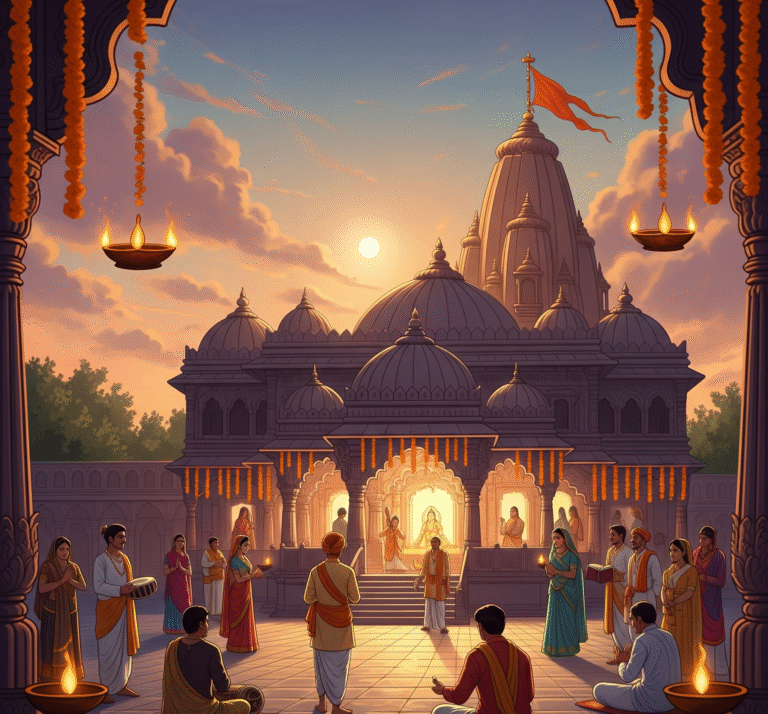
Raval, a serene village near Yamuna’s banks, is the holy ground where Vrishabhanu Maharaj and Kirtida Mata were blessed with their divine daughter, Shri Radha. Unlike ordinary births, Radha appeared as a golden-hued, radiant child who at first did not open Her eyes. It is said that Radha chose to open Her eyes only when Krishna came before Her—a divine symbol that Radha’s very existence is bound in love with Shyam.
Even today, Raval radiates a soft, motherly tenderness. The dust here feels lighter, the air gentler, as if carrying the lullabies sung to little Radha.
Raval marks the manifestation of Radha Tattva—the Hladini Shakti (divine pleasure potency) of the Lord. Without Radha, Krishna is incomplete, and without Krishna, Radha’s love has no purpose.
Saints proclaim: “Radha Krishna ek aatma, do deh.” – Radha and Krishna are one soul in two forms.
Pilgrims visit Raval not just to see temples, but to feel Radha’s childhood innocence, a love so pure that even the Yamuna flows quietly here.
Shri Radha Rani Temple (Raval Mandir) – The main temple marking Radha’s appearance spot. The idol of baby Radha here is worshipped with motherly devotion, as if She is still a child in Kirtida’s arms.
Vrishabhanu Bhavan – The ancient home of Vrishabhanu Maharaj, where Radha spent Her earliest days. Devotees feel the presence of Radha toddling in its courtyards.
Sacred Yamuna Ghats – Where Radha’s father performed rituals in gratitude for Her divine birth. Pilgrims bathe here, praying for Radha’s grace in their lives.
Radhashtami – Radha’s divine birthday is celebrated here with special grandeur. Pilgrims gather in thousands, singing Radha’s glories as the temple resonates with “Jai Jai Shri Radhe.”
Jhulan Utsav – Baby Radha is placed on a swing decorated with flowers, and devotees rock the swing while singing sweet lullabies.
Sharad Purnima – Celebrated with glowing lamps and kirtans, remembering Radha’s eternal Raas with Krishna.
Visiting Raval feels like entering Radha’s nursery. Devotees often bow down and collect the dust here, praying: “Radhe, bless me with prema.” The temple bells are softer, the bhajans gentler, as if sung like a mother’s lullaby.
When pilgrims gaze upon baby Radha’s idol, many describe tears flowing uncontrollably, as if they are standing not before a deity, but before their own divine daughter, their eternal mother, and their supreme beloved—all in one.

Sanket, located between Barsana and Nandgaon, is not just a geographical point but a divine meeting ground. It is here that Radha, leaving Her home in Barsana, and Krishna, leaving Nandgaon, would come together under the kadamba trees, guided by the songs of birds, the fragrance of jasmine, and the silent moon as their witness.
The very name Sanket means “signal” or “sign”—a place where secret messages of love were exchanged. Every leaf and breeze here is said to carry the codes of Radha and Krishna’s divine romance.
Sanket symbolizes Milan (union) in the eternal play of separation (viraha) and meeting (sambhoga) between Radha and Krishna.
Saints describe Sanket as the gateway of prema—where Radha-Krishna’s confidential leelas begin.
Even today, devotees feel a heightened sense of mystery here, as if walking into a divine secret hidden in plain sight.
Sanket Van (Sacred Grove) – The forest where Radha and Krishna met, its kadamba trees bending as if to shield Their divine union.
Sanket Kund – A small pond believed to have formed from the joyful tears of Radha and Krishna’s sakhis upon witnessing Their reunion.
Sanket Devi Temple – Dedicated to the guardian goddess of this land, who protected the secret meetings of Radha and Krishna. Devotees worship her before entering the groves.
Sharad Purnima – The night of the full moon, celebrated with lamps and kirtans, commemorating Radha-Krishna’s secret Raas Leela.
Sanket Milan Utsav – Locals reenact the secretive meeting of Radha and Krishna with bhajans and dramas.
Kartik Purnima Parikrama – Devotees include Sanket in their Braj Yatra, singing Radhe Shyam glories under moonlit skies.
A visit to Sanket feels unlike anywhere else in Braj. The forests are quiet, the breeze carries jasmine fragrance, and the moon seems to shine brighter here. Pilgrims often describe feeling a strange sweetness mixed with longing, as if Radha and Krishna have just passed by, leaving the air trembling with rasa.
In Sanket, one realizes that true love exists beyond the world’s eyes, in the sacred privacy of hearts united in devotion. Walking here at dusk, one feels both the excitement of secret love and the serenity of divine union.
This village is named after a tender vow of Krishna to the gopis. When they pleaded with Him not to leave, Krishna, with His mischievous smile, said:
“I will return the day after tomorrow—Parso.”
Even today, the breeze of Parso carries the ache of separation and the sweetness of eternal hope. Devotees feel as if Krishna will indeed arrive “tomorrow,” walking in from the horizon with His flute.
At Barsana, when Radha Rani expressed Her gentle pride, Krishna transformed into a peacock to dance before Her. With feathers shimmering and anklets jingling, He performed such a dance that Radha’s pride melted into pure love. The Mayur Kutir temple today stands as a reminder that Krishna bows even to Radha’s love.
A vast sandstone-bordered lake where Radha and the sakhis once gathered flowers for Krishna. At sunset, Kusum Sarovar glows with golden light, and pilgrims say the ripples sing Radha-Krishna’s names. Sitting here at dusk, one feels as if Radha Herself will appear, basket in hand, humming a divine tune.
These twin ponds are the crown jewels of Braj. When Krishna slew the demon Arishta, Radha playfully asked Him to purify Himself by bathing in holy rivers. Krishna struck the ground and invoked sacred waters, creating Shyam Kund. Radha, not to be left behind, created Radha Kund, which became even holier. Today, saints proclaim: “To bathe even once in Radha Kund is to taste the nectar of prema-bhakti.”
Barefoot, lasting 40 days.
Staying in dharamshalas, eating simple satvik meals, walking through forests and villages where every dust particle is Krishna’s charan raj.
Nights filled with bhajans, kirtans, and satsangs.
This yatra is not about covering distance—it is about being covered in devotion.
Shorter 7–10 day experiences by vehicle.
Includes darshans of key temples, Govardhan Parikrama, satsang evenings, and guided storytelling at leela-sthalis.
Perfect for those with less time, yet desiring to taste the essence of Braj’s nectar.
Both ways—whether walking slowly for 40 days or driving with guidance—the journey is not sight-seeing but soul-seeing.
October – March: Pleasant weather, full of festivities.
Special Occasions:
Kartik Purnima – A sacred full moon parikrama.
Radhashtami – Radha’s divine birthday in Barsana.
Holi – The legendary Lathmar Holi of Barsana & Nandgaon.
Annakut Mahotsav – Grand food offering at Govardhan.
Walk with humility – Remember, this is not dust, it is Krishna’s charan raj.
Chant constantly – “Radhe Radhe” is the password that opens every door and heart in Braj.
Travel light – Carry water, cotton clothes, and bedding if doing the traditional foot yatra.
Offer seva – Serve in gaushalas, join Yamuna aarti, or distribute prasadam.
Respect the Brajwasis – They are not mere villagers; they are Krishna’s eternal associates, living embodiments of devotion.
With these jewels of experience, the 84 Kos Braj Yatra transforms from a pilgrimage into a love story written on the soil of Vrindavan—where every step is Radha, and every breath is Krishna.